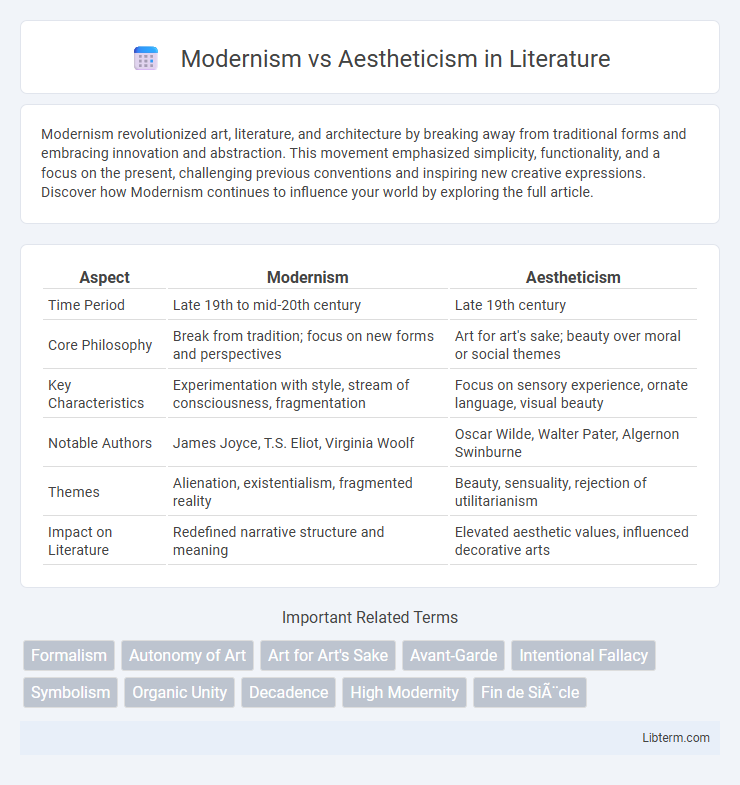Modernism revolutionized art, literature, and architecture by breaking away from traditional forms and embracing innovation and abstraction. This movement emphasized simplicity, functionality, and a focus on the present, challenging previous conventions and inspiring new creative expressions. Discover how Modernism continues to influence your world by exploring the full article.
Table of Comparison
| Aspect | Modernism | Aestheticism |
|---|---|---|
| Time Period | Late 19th to mid-20th century | Late 19th century |
| Core Philosophy | Break from tradition; focus on new forms and perspectives | Art for art's sake; beauty over moral or social themes |
| Key Characteristics | Experimentation with style, stream of consciousness, fragmentation | Focus on sensory experience, ornate language, visual beauty |
| Notable Authors | James Joyce, T.S. Eliot, Virginia Woolf | Oscar Wilde, Walter Pater, Algernon Swinburne |
| Themes | Alienation, existentialism, fragmented reality | Beauty, sensuality, rejection of utilitarianism |
| Impact on Literature | Redefined narrative structure and meaning | Elevated aesthetic values, influenced decorative arts |
Introduction to Modernism and Aestheticism
Modernism emerged in the late 19th and early 20th centuries as a response to industrialization and rapid societal changes, emphasizing innovation, abstraction, and a break from traditional forms. Aestheticism, flourishing in the late 19th century, championed "art for art's sake," prioritizing beauty and sensory experience over moral or social themes. The contrasting philosophies highlight Modernism's focus on progress and experimentation versus Aestheticism's dedication to visual pleasure and artistic autonomy.
Historical Roots and Philosophical Origins
Modernism originated in the late 19th and early 20th centuries as a response to rapid industrialization and cultural shifts, emphasizing innovation, fragmentation, and a break from traditional forms. Aestheticism, emerging in the mid-19th century, centered on the philosophy of "art for art's sake," prioritizing beauty and sensory experience over moral or social themes, drawing heavily on Romantic ideals. Philosophically, Modernism is influenced by existentialism and relativism, questioning objective truths, while Aestheticism is rooted in the belief that art exists independently of utility or ethical considerations.
Key Figures of Modernism and Aestheticism
Key figures of Modernism include T.S. Eliot, James Joyce, and Virginia Woolf, who revolutionized literature with experimental narrative techniques and fragmented structures. Aestheticism is epitomized by Oscar Wilde and Walter Pater, emphasizing art for art's sake and the pursuit of beauty over moral or social themes. The contrast between Modernism's focus on innovation and social critique and Aestheticism's dedication to sensory experience defines their respective literary movements.
Core Principles and Defining Characteristics
Modernism emphasizes innovation, experimentation, and a break from traditional forms, highlighting fragmented narratives, abstraction, and stream of consciousness techniques. Aestheticism prioritizes beauty and sensory experience over moral or social themes, advocating "art for art's sake," with intricate detail, rich imagery, and a focus on visual and sensual appeal. While Modernism challenges conventions and questions reality, Aestheticism celebrates art's form and decorative qualities without deeper ideological purpose.
Artistic Techniques and Stylistic Differences
Modernism embraces abstraction, fragmented forms, and experimental techniques such as stream of consciousness and collage, emphasizing innovation and subjective perception. Aestheticism prioritizes decorative detail, harmony, and beauty through elaborate patterns, refined lines, and sensual imagery, valuing art for art's sake. Stylistically, Modernism challenges traditional narratives with disjointed structures, while Aestheticism maintains elegance and formal coherence.
Literature: Comparing Modernist and Aestheticist Approaches
Modernist literature emphasizes experimental narrative techniques, fragmented structures, and a focus on inner consciousness, reflecting the complexities of modern life. Aestheticism prioritizes art for art's sake, valuing beauty, style, and sensory experience over social or political themes. While Modernism seeks to challenge traditional forms and engage with contemporary realities, Aestheticism centers on artistic perfection and detachment from moral or utilitarian concerns.
Influence on Architecture and Visual Arts
Modernism in architecture and visual arts emphasizes functionalism, minimalism, and the rejection of ornamentation, leading to innovative materials like steel and glass and abstract forms that reflect industrial progress. Aestheticism, characterized by its motto "art for art's sake," prioritizes beauty and decorative detail, drawing inspiration from historical styles and intricate ornamentation to create richly adorned facades and lush visual compositions. The Modernist movement profoundly reshaped urban landscapes with sleek, utilitarian designs, whereas Aestheticism influenced the Arts and Crafts movement and the elaborate visual style of the late 19th century.
Social, Political, and Cultural Impact
Modernism challenged traditional social norms by embracing industrialization and urbanization, promoting a break from Victorian values and advocating for progressive ideas like feminism and existentialism. Aestheticism emphasized "art for art's sake," resisting political or social engagement, which influenced cultural institutions by prioritizing beauty and craftsmanship over moral or utilitarian concerns. The political impact of Modernism was tied to its critique of capitalism and war, while Aestheticism maintained a cultural stance that often rejected contemporary societal issues, focusing instead on individual artistic expression.
Legacy and Ongoing Relevance
Modernism revolutionized literature and art by emphasizing innovation, abstraction, and a break from traditional forms, leaving a legacy that profoundly influences contemporary creative expression and critical theory. Aestheticism, with its emphasis on beauty, art for art's sake, and sensory experience, continues to shape modern design, fashion, and visual arts through its celebration of formal elegance and sensory appeal. Both movements remain relevant as they offer contrasting yet complementary frameworks for understanding the purpose and impact of art in society.
Conclusion: The Dialogue Between Modernism and Aestheticism
Modernism challenges traditional aesthetic principles by embracing innovation, abstraction, and social critique, whereas Aestheticism emphasizes beauty, art for art's sake, and sensory experience. The dialogue between these movements reveals a dynamic tension where modernist experimentation redefines beauty, while aestheticism insists on the intrinsic value of artistic expression. This interaction fosters a richer understanding of art's purpose, blending formal innovation with the pursuit of aesthetic pleasure.
Modernism Infographic

 libterm.com
libterm.com